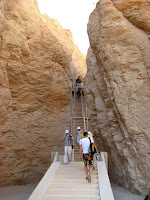 From where the riverboats dock, getting to the Valley of the Kings is a convoluted process. First you must drive 10 km south along the bank to cross a bridge, and then you must drive 10 km north along the bank before you are afforded entrance to the sacred valley. I almost wanted to ask why we couldn't park the riverboat on the other side. On the other hand, the drive afforded us the most picturesque scenery; lush, fertile farmland with sandstone cliffs jutting up behind it as trees bloomed with scarlet flowers I tried, but with no avail, to capture on film.
From where the riverboats dock, getting to the Valley of the Kings is a convoluted process. First you must drive 10 km south along the bank to cross a bridge, and then you must drive 10 km north along the bank before you are afforded entrance to the sacred valley. I almost wanted to ask why we couldn't park the riverboat on the other side. On the other hand, the drive afforded us the most picturesque scenery; lush, fertile farmland with sandstone cliffs jutting up behind it as trees bloomed with scarlet flowers I tried, but with no avail, to capture on film.When we arrived, we boarded a mini-train which took us part of the way through the valley and then it was us, thousands of tourists, and the sun, which was bound and determined to bake us into the sand. Six of the tombs are opened on a rotational basis and we had time enough to see three of them: Ramses IV, IX, and Tutmoses III. Tutmoses III's tomb is only to be visited by the most hearty of travelers. It involves several staircase
 s and ramps in order to get inside and due to the location of the tomb, and the amount of people visiting, being inside is much like a clay oven. On the other hand, his tomb is shaped in an oval, one of the only tombs to be done so, and the drawings on the wall are unlike the characteristic carvings seen on the temple and resemble hieroglyphic stick figures. Sadly, no photographs are allowed within the tombs. All of the tombs are covered with paintings from The Book of the Dead and the same smell of the pyramids permeates the air - a cross between age-old incense and decayed bodies.
s and ramps in order to get inside and due to the location of the tomb, and the amount of people visiting, being inside is much like a clay oven. On the other hand, his tomb is shaped in an oval, one of the only tombs to be done so, and the drawings on the wall are unlike the characteristic carvings seen on the temple and resemble hieroglyphic stick figures. Sadly, no photographs are allowed within the tombs. All of the tombs are covered with paintings from The Book of the Dead and the same smell of the pyramids permeates the air - a cross between age-old incense and decayed bodies.One tomb lies in the Valley of the Kings that even the most stalwart tourist will brave, and that is of King Tut Ankh Amun. An extra 100 L.E., the tomb is incredibly small, yet there are two things of note. Part of the multi-layered sarcophogus rests here, as well as the mummy of the boy-king himself. The mummy is encased in a glass box, only his head and feet are visible. While staring at the mummy I remembered, with foreboding, the legend of the curse of the pharaohs. Research shows that a biological trap (perhaps a poisonous gas) was left inside the tomb, for the archaeologists who discovered and opened his tomb, all died within a short period of time afterwards.
 On the backside of the Valley of the Kings is Hatshepsut's Temple. Queen Hatshepsut is a recent discovery, for her nephew, none other than Tutmoses III, attempted to erase her name from history. Fortunately for historians, news of her surfaced and her temple, a lavish three story affair was discovered. Not much can be seen after climbing the three sets of steps, but it does afford one a beautiful view of the Nile and the farmland, and one can see more tombs peppering the cliffs. Anywhere you look, it is much like a beehive, and I can imagine that many more tombs will be discovered in the coming years, perhaps one more ornate than that of King Tut Ankh Amun himself.
On the backside of the Valley of the Kings is Hatshepsut's Temple. Queen Hatshepsut is a recent discovery, for her nephew, none other than Tutmoses III, attempted to erase her name from history. Fortunately for historians, news of her surfaced and her temple, a lavish three story affair was discovered. Not much can be seen after climbing the three sets of steps, but it does afford one a beautiful view of the Nile and the farmland, and one can see more tombs peppering the cliffs. Anywhere you look, it is much like a beehive, and I can imagine that many more tombs will be discovered in the coming years, perhaps one more ornate than that of King Tut Ankh Amun himself.Driving back to the riverboat we stopped briefly to view two larger-than-life (and falling apart) statues called the Colossi of Memnon. The statues are in pieces and look like Ancient Rubiks Cubes, and are the only surviving parts of a temple from antiquity. A headless crocodile statues lies forgotten behind the colossi, keeping guard.
After this, we will set sail, soon to arrive at Edfu and Kom Ombo.

No comments:
Post a Comment